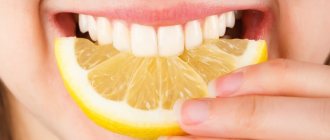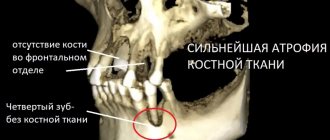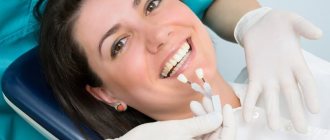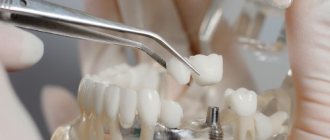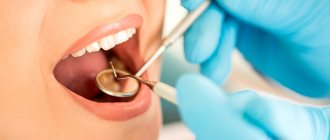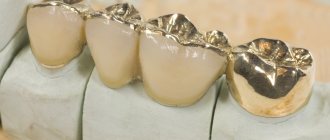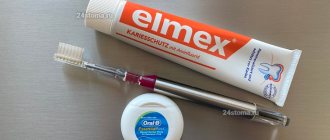Restoring a damaged tooth is a complex work aimed at preserving your dental unit and avoiding prosthetics or implantation. Modern dentistry offers a number of effective methods for treating a damaged tooth, even if only a two-millimeter root remains. In this material we will give answers to the most common questions regarding how to reliably restore a dental unit if it is more than half destroyed.
What teeth can be restored?
In dental practice, it is customary to consider those crowns that are missing more than 50% of their parts as a result of:
- carious lesion;
- mechanical injury;
- the presence of old fillings that do not collapse on their own, but caries develops underneath them;
- depulpation, against which the crown becomes fragile and changes color;
- increased abrasion of dentin, etc.
If you do not seek help from a dentist in time, restoring the unit will be problematic.
Injury
Single or chronic - the third reason for possible tooth chips
A single injury occurs when there is a blow, an accident, or accidentally biting on a hard object while chewing.
There are three types of chronic injury
- Due to malocclusion (when the teeth do not close correctly, some teeth may receive excessive load, close in the wrong areas, at the wrong angle, or with an opponent that is not their power). For example, a powerful fang of the lower jaw can be positioned in such a way that when closed, it will severely injure the incisor on the upper jaw, which is much inferior to it in size and power. As a result of such long-term closure, the incisor can get into big problems, and the patient will face the need for treatment or removal.
- Due to the absence of other teeth (when a number of teeth are missing, their work is performed by the remaining ones; excessive load may one day result in a fracture of the tooth, a break in its wall, or a split in the root).
- Due to bruxism (“idle” teeth grinding) or other parafunctional manifestations.
How to avoid?
- Be sure to restore missing teeth (there are a lot of ways today, there are even temporary prosthetics if for some reason you need to postpone dental treatment).
- Consult an orthodontist, orthopedist or periodontist about bite problems and undergo orthodontic treatment if indicated.
- Get advice from an orthopedist/gnathologist and psychotherapist about the possible causes of bruxism and take possible measures that the doctor recommends.
Is it possible to restore a damaged tooth?
Yes, you can. But everything will depend on the volume of the lost coronal part and the general condition of the oral cavity.
For restoration, modern dentists use the following two main methods:
- installation of pins (reinforcement) made of fiberglass or titanium;
- introduction of so-called stump inlays.
If more than 50% of the unit is destroyed, and the dentist has doubts that the crown restored with a stump or pin will not withstand the chewing load, a metal-ceramic crown is installed on the stump pin inlay. When restoring teeth, it is mandatory to clean and fill the canals to avoid the development of caries.
What to choose?
What to install if there is no root - a removable denture, a bridge or an implant? The dentist will select prosthetic options based on the condition of the oral cavity and the presence of relative or absolute contraindications. However, today doctors most often offer implant prosthetics. It has only two disadvantages compared to other types - a higher price and a longer period of prosthetics with several stages. However, this is compensated by excellent, long-term and predictable results. In addition, implantation technologies are constantly being improved; there are already techniques and implants that can significantly reduce the time of prosthetics.
Light filling on a pin – what are the advantages of the method?
A post filling is considered a reliable replacement material when a dentist is restoring a fractured unit. A titanium or fiberglass pin is inserted into the root canal, after which the coronal part is restored with a composite material. Among the disadvantages of the method is the potential risk of root fracture, since the pin fails under pressure, as well as shrinkage of the filling and the development of secondary caries under it.
Unfortunately, teeth restored in this way do not last forever. After 3–5 years, the dentist will have to change the filling or, due to global destruction of the crown, perform prosthetics/implantation.
Strength of the restored jaw and recommendations for care
The service life largely depends on how clearly the patient follows the recommendations of the attending physician. According to standards, composites last about 5 years without changing their basic characteristics, ceramics - 15, lumineers - 20. But this is only with careful treatment, quitting smoking, and maintaining oral hygiene.
Otherwise, marginal pigmentation quickly appears, shine is lost, and the risk of caries increases. It is very important to follow the restrictions on the first day. To do this, you can eat food no earlier than 2-3 hours after the procedure. It is better to drink tea, coffee, juices with a high acid content and intense coloring only after 1-2 days. It is also advisable to refrain from applying lipstick during this time.
How to restore a damaged tooth?
Treatment of a damaged tooth involves the following steps:
- examination by a dentist and assessment of further “future” damaged teeth;
- restoration of the stump area using a pin or inlay. The dentist treats the canals, strengthens the unit from the inside, thereby providing reliable support for the filling;
- The crown is built up using a composite material. If the work is done efficiently, the tooth can be visually almost indistinguishable from a natural one. The dentist repeats the shape, color and even transparency.
Installation of crowns
Prosthetics with crowns is a reasonable way to restore quality of life and restore the functionality of a severely damaged unit. Today it is possible to make beautiful and comfortable dentures at an affordable price.
Metal-ceramic crowns on teeth
If chewing teeth have been damaged, then the most affordable way to restore them is the use of metal-ceramics. Such crowns for sixth teeth or other molars will be strong and aesthetically pleasing. The ceramic coating visually brings them closer to natural teeth, and the solid metal base allows you to chew familiar foods without fear.
Metal ceramics
– a compromise look that combines comfort, quality and attractiveness. Chewing teeth actively work under significant load; the metal will be stronger than its own enamel.
The method of making such crowns:
- An impression is made.
- Based on the wax model, a one-piece structure is created in the dental laboratory, repeating all the shapes of the recreated dental crown.
- Layers of ceramic are applied to the model, each of which is baked at high temperature.
It is recommended to follow the usual precautions - do not eat hot and ice-cold food at the same time. With a sharp change in temperature, the ceramic surface may crack. This way of eating is also harmful to the “native” enamel.
How much does it cost to make a metal-ceramic crown on a tooth? For me – from 17,900 rubles for 1 tooth. If you need several prostheses, then flexible pricing applies. Accordingly, if the patient wants to restore a tooth not with metal-ceramics, but with ceramics, then there are no problems, he will be offered only the best materials e-max and zirconium dioxide.
Previously, in case of serious damage, a pin and a filling were used to recreate the stump in order to place a crown on the tooth on such a support. Nowadays, more and more people are switching to Cerec technology and restoring teeth using single “crown + root” modules, which is stronger and more reliable. And most importantly, it is much faster in time and costs less in total:
Come to me, Dr. Sergei Samsakov, and we will assess the condition of the problematic tooth and choose a method to restore it. If a tooth is broken, let's see if it is possible to put a crown and what material is better to choose. All manipulations are performed without pain, in a comfortable environment.
Sections
- Indications and contraindications for the procedure
- Materials for restoration and restoration of teeth
- Stages of professional teeth cleaning, restoration and restoration
- Artistic restoration of the front tooth
- Equipment of dental clinics "Zubastic" for restoration and restoration of teeth
- Advantages of dental restoration and restoration in our clinic
- Sign up for dental restoration at the Zubastik clinic
To restore the front teeth, dentists use the method of artistic restoration. This is delicate, jewelry work, since the composite must exactly match the color of a healthy tooth in shade and texture.
For anterior teeth, a material with fine fillers is chosen, for chewing units - composites with hard, large particles. Such fillings exhibit minimal shrinkage and retain their original shape for years, which eliminates the risk of falling out or chipping.
Prevention of destruction
Nobody wants to visit the dental clinic one more time for dental restoration. However, statistics show that destruction of elements, ranging from caries at the spot stage to deep caries, is observed today in 75% of Russian residents. This is due to many factors. Smoking and alcohol, excessive consumption of carbonated drinks, sweets, natural and artificial dyes have a very negative effect. Of no small importance is genetic predisposition, as well as irregular oral care, which leads to the formation of plaque and tartar, which requires immediate dental restoration. But even after it’s done, you shouldn’t think that a charming smile will remain forever without any effort. Any patient can maintain an attractive appearance after dental restoration; you just need to listen to the doctor’s recommendations and regularly carry out simple preventive procedures. Dentists recommend:
- after restoration, extension, installation of veneers or lumineers, see a doctor at least once every six months;
- Be sure to brush your teeth twice a day, morning and evening; in the first 3 months after dental restoration, it is better to purchase a soft brush;
- subsequently it is necessary to use dental floss, or better yet, special brushes that do not cause damage to the gums;
- After each meal, use rinses without aggressive components; if they are absent, use ordinary, preferably boiled, water.
Simple precautions will help protect the elements restored during the dental restoration process. Crowns, composite materials, veneers and lumineers are effective ways to restore aesthetic and chewing functions, the choice of which remains with the specialist. The VivaDent clinic employs qualified doctors with higher education who spare no time in studying innovative trends. Dentistry is progressing by leaps and bounds, and it is gratifying that our company is a trendsetter in Russia today. Powerful medical equipment, the presence of our own laboratories in each branch, and the use of high-tech materials allow us to solve the most complex problems in the field of dental restoration. We even take on those cases that are refused in other places, because we are confident in our abilities. Our employees generously share their optimism with patients who know: visiting the VivaDent clinic for dental restoration will leave only positive emotions and give you the opportunity to smile dazzlingly!
Advantages of veneers
Indirect dental restoration using the installation of the thinnest plates is in demand today not only by public figures, but also by ordinary people who dream of eliminating imperfections of elements. Veneering involves grinding down 0.5–0.7 mm, after which plates of the selected shade made from individual impressions are glued onto the polished surface. Dental restoration using this method involves processing from 4 to 10 units in a row, that is, a plate is not placed on a separate element. There are some contraindications for the installation of such structures: grinding gums (bruxism), pathological inflammation of soft tissues, a high degree of abrasion of hard tissues on which it is impossible to attach elements. In addition, the installation of onlays is not recommended in the presence of dentures made of hard materials. Otherwise, indirect dental restoration has many advantages.
- The high aesthetic component of the procedure allows you to create a dazzling smile and hide imperfections.
- Sufficient mechanical strength of the plates, resistance to temperature changes, and the influence of food coloring.
- The tight fit of the plates protects the enamel from external influences, protects it from destruction, and prevents the penetration of bacteria.
- The ability to bind together disparate elements, reducing loosening that occurs with age.
- Elimination of yellowness, fluorosis, chips and microcracks resulting from damage and injury.
- The possibility of covering not only the front part, which preserves the taste sensitivity of the units, but also “dressing” the tooth on both sides to increase strength.
NEED TO KNOW! Veneers can be ceramic, composite or zirconium. The former are distinguished by a higher aesthetic component and increased whiteness. However, ceramics is a rather fragile material. Polymer-based composites are characterized by a less attractive appearance, but are more practical and quite affordable. Zirconium guarantees the longest life of the plates.
